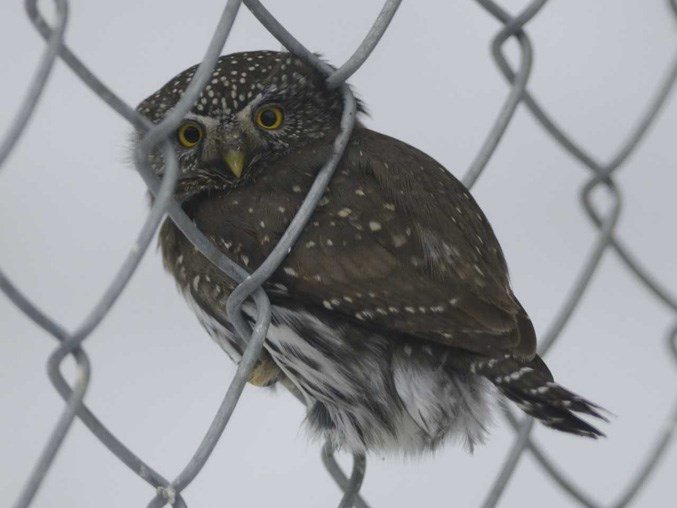The High Country area is abundant with chickadees and Canada jays, yet great horned owls failed to make an appearance in a recent bird count.
Twenty-nine people spotted 43 species of birds amongst 2,869 sightings in nine locations in the Audobon Christmas Bird Count for the Sheep River area Dec. 27. The area has a 12-kilometre radius that includes Turner Valley and Millarville.
While Doug Collister, a biologist who specializes in birds and collects the local data, considers the findings average, he says some species stood out.
For instance, participants spotted 160 Canada jays – topping other counts across North America, he said.
“The last few years the numbers have been down, but this year we counted the highest number of Canada jays we’ve ever had,” Collister said.
Another surprising count was 217 mountain chickadees, he added.
“The species has increased significantly over the Sheep River count’s 28 years,” he said. “It may be related to increased country residential living and more people feeding. They’re a high-altitude chickadee so I don’t know why they’re coming down more.”
Another bird that made quite an appearance was the white winged crossbill. Collister said 718 were spotted.
“Their specialization is opening spruce and pine cones,” he said. “Some winters there are none around and some winters, like this one, they’re everywhere. Last year we had 11 and the year before zero. Four years ago we had 700. This is a good year for them. The spruce trees are loaded with cones.”
A species Collister suspects is declining in the area is the great horned owl, of which the Sheep River counters saw none.
“Great horned owls were more common, but they’re hard to find now,” he said. “I’m a little concerned that there’s some persecution going on. They are big strong bird and can go after cats and chickens.”
Collister submits the Sheep River count data to the National Audobon Society in the United States. The statistics are also used by Bird Studies Canada.
“Quite a few scientific papers use this data, which is a little rough because people have different abilities to identify birds and there’s potential for double counting,” he said. “It determines population trends.”
Avid birder Barb Castell, who counts birds 365 days a year, compiled her own statistics.
Throughout 2018, Castell spotted 97 species on her Millarville area property.
The avid birder has a live feed on her bird feeders and sends the data to the Cornell Institute of Business and Technology. The statistics are available at ebirders.com
“Every day I count every bird that comes onto my property,” she said, adding 97 species is up from 89 in 2017. “I’m just a bird nut. I’ve been bird-watching all my life.”
Castell will sometimes see a bird species only once. Last year it was the great horned owl, western tanager and northern pygmy owl.
“I got a picture in a fence of this little tiny bird,” she said of the owl. “It sat there and visited us for a while.”
As for redpolls, Castell saw thousands.
“Sometimes you see 200 on the ground all at once,” she said.
Other frequent visitors to Castell’s yard were blue jays, chickadees and woodpeckers.
Her favourite is the black-capped chickadee.
“They are always bouncing around and happy and they will land in your hand,” she said. “They have a lovely song in the spring. They are here all year round. I don’t ever get tired of having chickadees here.”
Castell looks forward to the hummingbirds every year. She often plants flowers just for them.
“Just to sit outside on a hot day and watch them go from flower to flower is amazing,” she said. “They barely weigh anything - they’re all feathers and wings. I’m amazed they can fly all the way from South America to visit me three or four months, nest, have babies, raise them and go back.”
Some birds are more elusive like the loon, which Castell admires from afar. They often fly overhead or stay briefly in her pond.
Castell’s property draws thousands of birds with its heated water in the winter, 14 birdfeeders, two suet feeders and two peanut-butter feeders.
“I probably go through 10 to 50 pound bags every six weeks,” she said. “It’s my little hobby.”
Castell’s success in attracting birds has not gone unnoticed by birders.
“My place is well-known amongst the birders so I get birders dropping in here,” she said. “It’s a little destination. It’s a connected world of people who have a love for birds.”
Last winter, National Geographic photographed grosbeaks on her property.
“I’m about the only one around here that gets evening grosbeaks,” she said. “I can get around 60 in a day. Everybody comes here to photograph them.”
Other species, which Castell spotted last year were geese, ducks, grouse, doves, killdeer, snipes, gulls, hawks, herons, merlin, magpies, crows, ravens, swallows, wrens, thrushes, bluebirds, robins, waxwings, finches and warblers.



.JPG;w=120;h=80;mode=crop)
